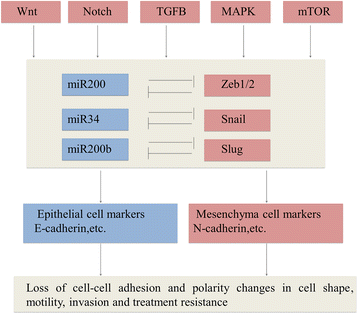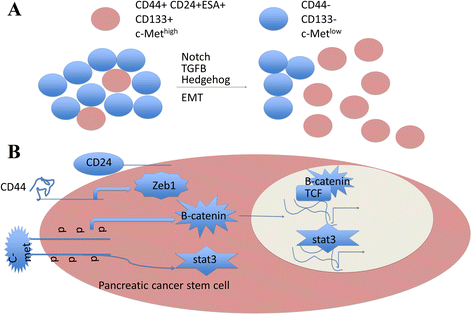The epithelial to mesenchymal transition (EMT) and cancer stem cells: implication for treatment resistance in pancreatic cancer
- PMID: 28245823
- PMCID: PMC5331747
- DOI: 10.1186/s12943-017-0624-9
The epithelial to mesenchymal transition (EMT) and cancer stem cells: implication for treatment resistance in pancreatic cancer
Abstract
The mechanical properties of epithelial to mesenchymal transition (EMT) and a pancreatic cancer subpopulation with stem cell properties have been increasingly recognized as potent modulators of the effective of therapy. In particular, pancreatic cancer stem cells (PCSCs) are functionally important during tumor relapse and therapy resistance. In this review we have surveyed recent advances in the role of EMT and PCSCs in tumor progression, metastasis and treatment resistance, and the mechanisms of integrated with biochemical signals and the underlying pathways involved in treatment resistance of pancreatic cancer. These findings highlight the importance of confirming stem-cells markers and complex molecular signaling pathways controlling EMT and cancer stem cells in pancreatic cancer during tumor formation, progression, and response to therapy.
Keywords: Cancer stem cell; Epithelial-to-mesenchymal transition; Pancreatic cancer; Resistance.
Figures


Similar articles
-
Pancreatic cancer stem cells: new insight into a stubborn disease.Cancer Lett. 2015 Feb 28;357(2):429-37. doi: 10.1016/j.canlet.2014.12.004. Epub 2014 Dec 8. Cancer Lett. 2015. PMID: 25499079 Review.
-
Epithelial Mesenchymal Transition in Aggressive Lung Cancers.Adv Exp Med Biol. 2016;890:37-56. doi: 10.1007/978-3-319-24932-2_3. Adv Exp Med Biol. 2016. PMID: 26703798 Review.
-
MicroRNA-200c overexpression plays an inhibitory role in human pancreatic cancer stem cells by regulating epithelial-mesenchymal transition.Minerva Med. 2015 Aug;106(4):193-202. Epub 2015 Jun 17. Minerva Med. 2015. PMID: 26081037
-
CCL21/CCR7 Axis Contributed to CD133+ Pancreatic Cancer Stem-Like Cell Metastasis via EMT and Erk/NF-κB Pathway.PLoS One. 2016 Aug 9;11(8):e0158529. doi: 10.1371/journal.pone.0158529. eCollection 2016. PLoS One. 2016. PMID: 27505247 Free PMC article.
-
Cancer stem-like cells enriched with CD29 and CD44 markers exhibit molecular characteristics with epithelial-mesenchymal transition in squamous cell carcinoma.Arch Dermatol Res. 2013 Jan;305(1):35-47. doi: 10.1007/s00403-012-1260-2. Epub 2012 Jun 28. Arch Dermatol Res. 2013. PMID: 22740085
Cited by
-
Identification of a Twelve Epithelial-Mesenchymal Transition-Related lncRNA Prognostic Signature in Kidney Clear Cell Carcinoma.Dis Markers. 2022 Mar 23;2022:8131007. doi: 10.1155/2022/8131007. eCollection 2022. Dis Markers. 2022. PMID: 35371341 Free PMC article.
-
Ping-Pong-Tumor and Host in Pancreatic Cancer Progression.Front Oncol. 2019 Dec 16;9:1359. doi: 10.3389/fonc.2019.01359. eCollection 2019. Front Oncol. 2019. PMID: 31921628 Free PMC article. Review.
-
ZEB1 promotes DNA homologous recombination repair and contributes to the 5-Fluorouracil resistance in colorectal cancer.Am J Cancer Res. 2023 Sep 15;13(9):4101-4114. eCollection 2023. Am J Cancer Res. 2023. PMID: 37818077 Free PMC article.
-
SKA1 regulates actin cytoskeleton remodelling via activating Cdc42 and influences the migration of pancreatic ductal adenocarcinoma cells.Cell Prolif. 2020 Apr;53(4):e12799. doi: 10.1111/cpr.12799. Epub 2020 Mar 30. Cell Prolif. 2020. PMID: 32232899 Free PMC article.
-
Conversion of epithelial-to-mesenchymal transition to mesenchymal-to-epithelial transition is mediated by oxygen concentration in pancreatic cancer cells.Oncol Lett. 2018 May;15(5):7144-7152. doi: 10.3892/ol.2018.8219. Epub 2018 Mar 8. Oncol Lett. 2018. Retraction in: Oncol Lett. 2022 Apr;23(4):107. doi: 10.3892/ol.2022.13227. PMID: 29731878 Free PMC article. Retracted.
References
Publication types
MeSH terms
Substances
LinkOut - more resources
Full Text Sources
Other Literature Sources
Medical

